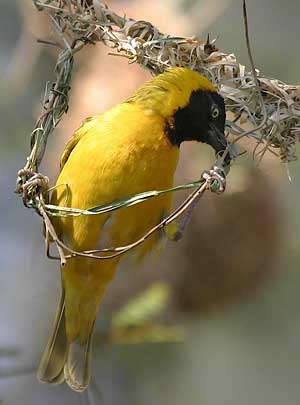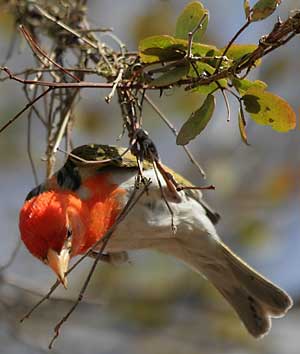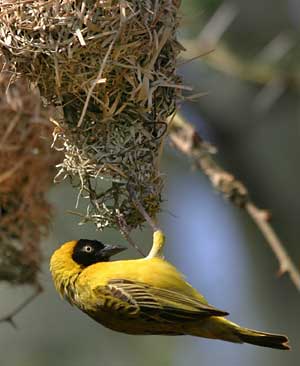Contact Details: Scotch Macaskill, Dirt Road Traders, Currys Post Road, Howick, KwaZulu-Natal, South Africa. Tel: +27 (0)82 578 2329. Privacy: Your privacy is guaranteed. See our Privacy Policy for more. This site accepts advertising and other forms of compensation - see Disclosure and Advertising for details. Site updated: 2022. Copyright © 2002 - 2022 Scotch Macaskill

| ||||||||||
|
||||||||||
|
SEE ALL
|
Weaver Birds Brighten Up Our Livesby Roddy SmithThe weavers make up a group of birds which are very easily recognised both by appearance and behaviour by most people in southern Africa, even those who are not particularly interested in birds. Those belonging to the genus Ploceus are particularly familiar.

Lesser Masked Weaver (Ploceus intermedius) In the breeding season they are possibly our most conspicuous group of birds, with the males of most species a predominantly bright yellow colour (left) and anything but shy: they are very vocal and extremely active and all this activity is centred around the nesting sites, which are usually in places that are very easy to see. In non-breeding season these colours fade to a less conspicuous shade and they are generally much less visible in their behaviour. This is probably to make them less obvious to predators, and in particular to raptors such as goshawks that habitually prey on small birds. This raises the question as to why they should make themselves conspicuous for several months of the year if it exposes them to greater danger, and, as so often in nature, it comes down to the need to procreate, where chances of personal survival must be traded against opportunities to pass on one's genes. The bright colours of the males are all to do with the intense competition to breed. On the one hand they are advertising their availability to females and at the same time they are warning other competing males off their particular patch. It is not difficult to draw a parallel with young testosterone-filled human males showing off for the same reasons: our in many ways artificially constructed lifestyle has not yet managed to sever our evolutionary roots. There are other parallels: it may be the male's clothes and song which initially get the female's attention, but it is his material assets which determine whether she finally shacks up with him. The male builds an intricate nest which the female then inspects; if it is up to the required standard she moves in, but if not she may pull it to pieces and make him start again, or else reject him in favour of someone with a better house. Nature's Little WondersIt is because of this nesting behaviour for which the weavers are named, that this group of birds is so well known, and indeed their nests are one of nature's little wonders. I have freqently examined a weaver's nest, marvelling at the fact that a bird, using only its beak, can weave something so intricate and so consistent that I could never reproduce it with my hands.

Redheaded Weaver (Anaplectes rubriceps) using its beak to weave the nest The weavers are born knowing how to do this; even birds raised in captivity succeed in building nests to the pattern of their particular species. There is some learning involved — as birds get older they seem to build better and stronger nests. They also know instinctively which materials to use, favouring fresh green blades of grass or strips of palm leaf. Not only are these more flexible than dry leaves but as they dry they contract and tighten the knots the birds use to fasten them. While all the weavers of the genus Ploceus are generally similar, there are subtle differences between the species — in appearance, in nest design and and in social behaviour. The Spectacled Weaver for instance is monogamous: the pairs stay together year-round for at least a few years and possibly for life, and the nests are usually solitary. Most species, however, including the Southern Masked-Weaver, Lesser Masked-Weaver and Village Weaver (previously Spotted-backed but let's not go there), have a more traditionally African approach: they are polygamous, with a male having two to three mates simultaneously, each with her own nest, and (in the Village Weaver) up to 12 mates in a season. This seems to me ambitious to the point of foolhardiness, as the male has not just one but several females pulling his constructions to bits.

Lesser Masked Weaver (Ploceus intermedius) adding the finishing touches to the nest spout More sensibly it seems that in certain species the male builds only the basic structure for inspection; having once obtained the female's approval he then adds the spout (differing in length and shape according to species) and then the female lines the nest in preparation for laying (again this varies according to species). All the polygamous species tend to be colonial nesters in trees or reed-beds, and quite often a favoured nest-site will have nests of several different species. Nests in trees are usually at the ends of hanging branches which may make it more difficult for predators to get into them. The nest site is often used year after year although new nests are built every season and the males are intensely territorial, vigorously defending their little patch within the colony from their neighbours. Roddy Smith is a wildlife conservationist and safari guide based at Mwambashi River Lodge in the Lower Zambezi National Park, Zambia. Images © Scotch Macaskill Return to Wildlife Articles |
|||||||||
|
|
||||||||||